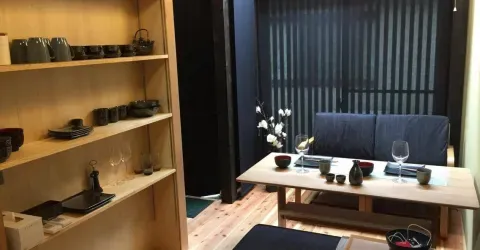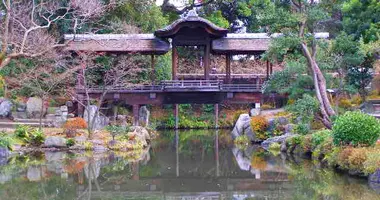Katsura Rikyu Imperial Villa Kyoto 桂離宮
Katsura Rikyu, situated in southwest Kyoto, is one of the two Imperial Villas in the ancient capital (the other is Shugakuin Imperial Villa). It was planned in painstaking detail to be a place of high aesthetic beauty and an ideal example of Japanese Villa design.
Katsura Imperial Villa
Aliona Jefimova
Japanese traditional architecture designed by the most skillful masters, exotic trees, a lake with an elaborate shoreline, and beautiful views from any spot within the villa make Katsura Rikyu famous all over Japan and beyond.
History
Katsura Imperial Villa was established in 1615 at the commission of Prince Toshihito, the younger brother of Emperor Goyozei. However, most of the buildings that we see today have been added by Toshihito's son Prince Toshitada around 1649.
Main House At Katsura Rikyu
The main cluster of houses in Katsura Rikyu consists of three structures: Ko-shoin, Chu-shoin and Shin-goten. Each was built in a different time period, Ko-shoin being the oldest and Shin-goten being the newest. Unfortunately, tourists are not allowed to enter these buildings nowadays but you can enjoy the view of their exterior and get an impression of the interior from the video shown at the beginning of the tour that is available for visitors.
Ko-shoin has a veranda (Tsukimi-dai) that has been built for moon viewing. This veranda protrudes from a broad passageway along the building and overlooks the garden and the lake.
Chu-shoin accommodates valuable wall paintings by Kano Tan'yu and Kano Yasunobu, the great masters of Kano school.
Shin-goten was built for the occasion of a visit by the retired emperor Gomizuno-o. There is a vast open lawn near the main structure of the villa that was used by courtiers for archery or kemari, an ancient court football game.
Tea Houses At Katsura Rikyu
The tea ceremony has been an important tradition in Japan since ancient times. Wealthy people would conduct tea ceremonies in specially built tea pavilions while socializing with friends, enjoying beautiful views, reciting poetry, and talking about art. Therefore, an imperial villa cannot be imagined without a tea pavilion.
There are four tea pavilions in Katsura Rikyu. They might look similar to each other at first glance, but if you know the story of their creation and the idea the designer wanted to transmit to visitors, you will feel the special atmosphere each of them has and understand the creator's ingenuity.
Shokin-tei
Shokin-tei (interior, pictured below) is the most socially prestigious structure for tea ceremony in Japan.
Depending on the place the observer is standing, the perspective of the interior changes dramatically. Although it is a traditional Japanese tea pavilion, the sliding door, along with the alcove of the first room, has an unexpectedly modern blue-and-white checked pattern.
This is in contrast with the general atmosphere of the teahouse and the paintings by Kano Tan'yu. The entrance was deliberately made very small so that a person with a sword would not be able to enter, making it a place for peaceful meetings.
Shoka-tei (Flower-Viewing Teahouse) is located on the highest elevation of the villa. It is the best place for enjoying the view of cherry blossoms and wisteria in the spring, but is equally pleasant on hot summer days.
Shoi-ken teahouse has an atmosphere of a country farmhouse. Although the entrance faces the lake, visitors can see vast rice fields through the windows opposite the entrance. The rice paddies have been purchased by the government for the purpose of preserving the original atmosphere of the villa.
There are three rooms in the teahouse that are separated by fusuma (sliding doors). The ceiling, however, has been left un-partitioned in order to create an appearance of spaciousness inside. Under the windows of one room you can see a decorative line of golden foil and velvet that has been imported from Europe and was considered to be a luxury at the time. Paintings by Kano Naonobu decorate the interior of another room.
The fourth tea pavilion, Geppa-ro, left the deepest impression. This teahouse was designed for watching the reflection of the moon in the lake. It has two rooms with windows that recall the magnificent painted scrolls. From the window of the first room you can see a beautiful hill with trees, especially gorgeous in autumn, which is called Momiji-yama (Japanese maple mountain) and symbolizes the land.
Another window faces the pond and Shokin-tei and symbolizes the sea. The ceiling of Geppa-ro has been designed to remind one of the bottom of a sailing boat. Therefore, visitors of the teahouse observing the pond are given the impression they are on a sailing boat.
The Garden
Most of the villa's grounds consist of a Japanese garden that has been carefully planned and features various species of exotic plants, including cycad and palm trees. The popular "shakkei," or "borrowed landscape"--a garden that employs the surrounding landscape and incorporates into the view of the garden itself--has been used in this garden. A copy of Amano-hashidate in Kyoto Prefecture, which is known as one of the three most scenic spots in Japan, can be seen best from the Shokin-tei teahouse. Visitors should pay attention to lanterns and hand washbasins along the winding paths, as none of them look the same.
At the end of the tour you will see a pine tree that has been planted in front of the lake in order to prevent viewing the whole garden at once. This ingenious idea ensures pleasure for visitors, who stroll along the paths of the garden and continuously discover new scenic spots.
How to apply for a visit to Katsura Rikyu
To visit Katsura Rikyu, permission from the Imperial Household Agency is required. To apply, go to the Agency office in the northwestern part of the Kyoto Imperial Park (Gosho). Alternatively, you can apply online:
Imperial Household Agency (sankan.kunaicho.go.jp)
You will be given a specific time and date on which your tour will begin. Do not come late. You should come to the destination 10 minutes prior to the departure of the tour.
Guided tours in Katsura Villa are in Japanese only, but there are audio guides available in English.
The tour and the audio guides are both free.
Things to remember when visiting Katsura Rikyu
- Reservations are required. Do so as far in advance as possible.
- Fall (late-October to December) is the most crowded time of year.
- Arrive before your appointed tour time. If you are late, you will not get in.
- Wear comfortable shoes.
Address, timetable & access
Katsura Imperial Villa
Address
Katsuramisono, Nishikyo Ward
615-8014
Japan
Phone
+81 (0)75 211 1215Access
Katsura Station lies a 20 minute walk west of Katsura Imperial Villa. Katsura Station is on two Hankyu lines; the Arashiyama Line to Arashiyama Station and the Kyoto Line to Kawaramachi Station in Kyoto and Umeda Station in Osaka. From Kyoto Station bus stop take the Keihan buses (14, 2, 28, 28A, 28B, 15, 26, 26B) to the Katsura Rikyu-mae stop (桂離宮前) outside the south side of the garden. It's an 8 minute walk to the garden.Website
https://sankan.kunaicho.go.jp/english/index.html































